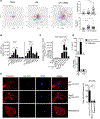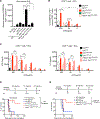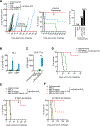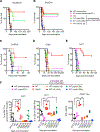Inflammasomes within Hyperactive Murine Dendritic Cells Stimulate Long-Lived T Cell-Mediated Anti-tumor Immunity
- PMID: 33207188
- PMCID: PMC7727444
- DOI: 10.1016/j.celrep.2020.108381
Inflammasomes within Hyperactive Murine Dendritic Cells Stimulate Long-Lived T Cell-Mediated Anti-tumor Immunity
Abstract
Central to anti-tumor immunity are dendritic cells (DCs), which stimulate long-lived protective T cell responses. Recent studies have demonstrated that DCs can achieve a state of hyperactivation, which is associated with inflammasome activities within living cells. Herein, we report that hyperactive DCs have an enhanced ability to migrate to draining lymph nodes and stimulate potent cytotoxic T lymphocyte (CTL) responses. This enhanced migratory activity is dependent on the chemokine receptor CCR7 and is associated with a unique transcriptional program that is not observed in conventionally activated or pyroptotic DCs. We show that hyperactivating stimuli are uniquely capable of inducing durable CTL-mediated anti-tumor immunity against tumors that are sensitive or resistant to PD-1 inhibition. These protective responses are intrinsic to the cDC1 subset of DCs, depend on the inflammasome-dependent cytokine IL-1β, and enable tumor lysates to serve as immunogens. If these activities are verified in humans, hyperactive DCs may impact immunotherapy.
Keywords: CD8+ T cells; IL-1β; anti-tumor immunity; dendritic cells; hyperactivation; inflammasomes; pyroptosis.
Copyright © 2020 The Author(s). Published by Elsevier Inc. All rights reserved.
Conflict of interest statement
Declaration of Interests J.C.K. holds equity and consults for IFM Therapeutics, Quench Bio, and Corner Therapeutics. A.K.S. reports compensation for consulting and/or SAB membership from Merck, Honeycomb Biotechnologies, Cellarity, Repertoire Immune Medicines, Orche Bio, and Dahlia Biosciences. D.Z. holds equity and consults for Corner Therapeutics. Boston Children’s Hospital has filed patents related to the use of hyperactivating stimuli and hyperactive DCs in the treatment of disease. J.C.K. serves on the advisory board of Cell Reports.
Figures







References
Publication types
MeSH terms
Substances
Grants and funding
- R01 AI093589/AI/NIAID NIH HHS/United States
- R56 AI093589/AI/NIAID NIH HHS/United States
- K08 AI121421/AI/NIAID NIH HHS/United States
- T32 AI007245/AI/NIAID NIH HHS/United States
- R37 AI116550/AI/NIAID NIH HHS/United States
- DP2 GM119419/GM/NIGMS NIH HHS/United States
- R01 AI121066/AI/NIAID NIH HHS/United States
- P30 DK034854/DK/NIDDK NIH HHS/United States
- U19 AI133524/AI/NIAID NIH HHS/United States
- R01 DK115217/DK/NIDDK NIH HHS/United States
- T32 HL116275/HL/NHLBI NIH HHS/United States
- R01 AI116550/AI/NIAID NIH HHS/United States
- RM1 HG006193/HG/NHGRI NIH HHS/United States
- U54 CA217377/CA/NCI NIH HHS/United States
LinkOut - more resources
Full Text Sources
Other Literature Sources
Molecular Biology Databases
Research Materials

